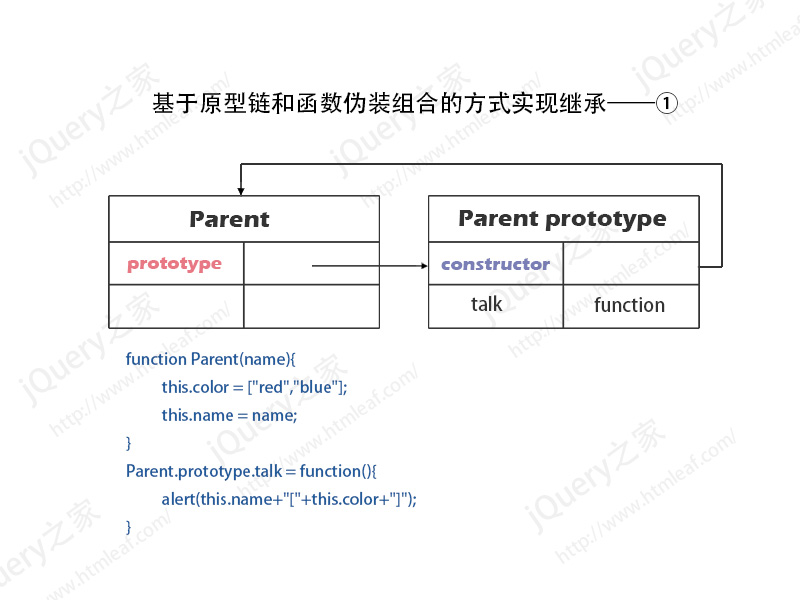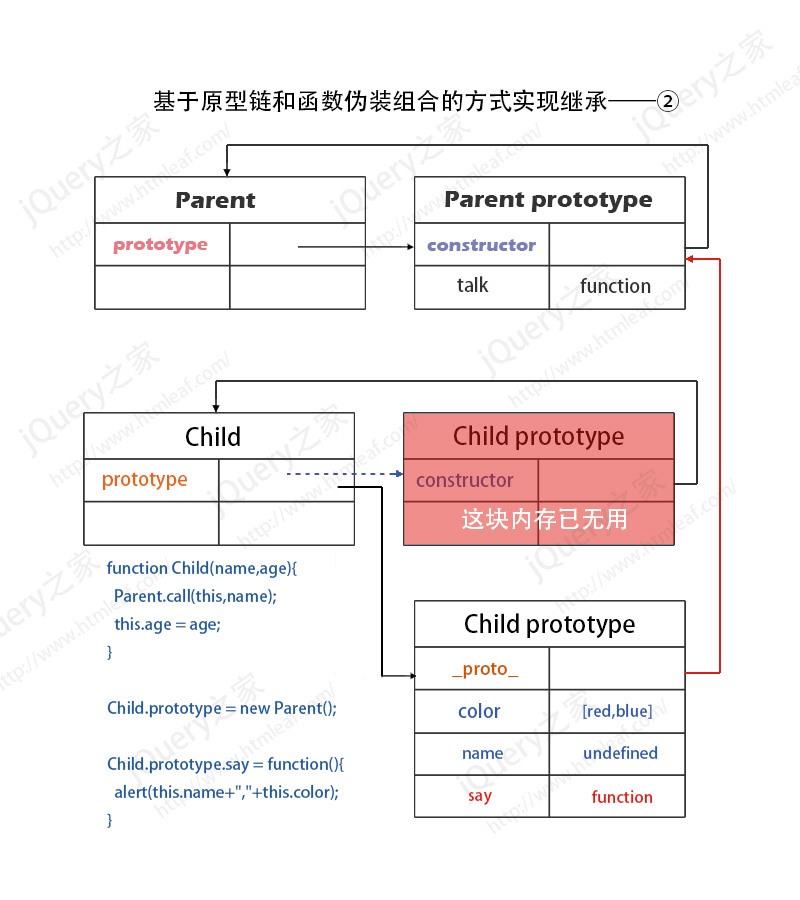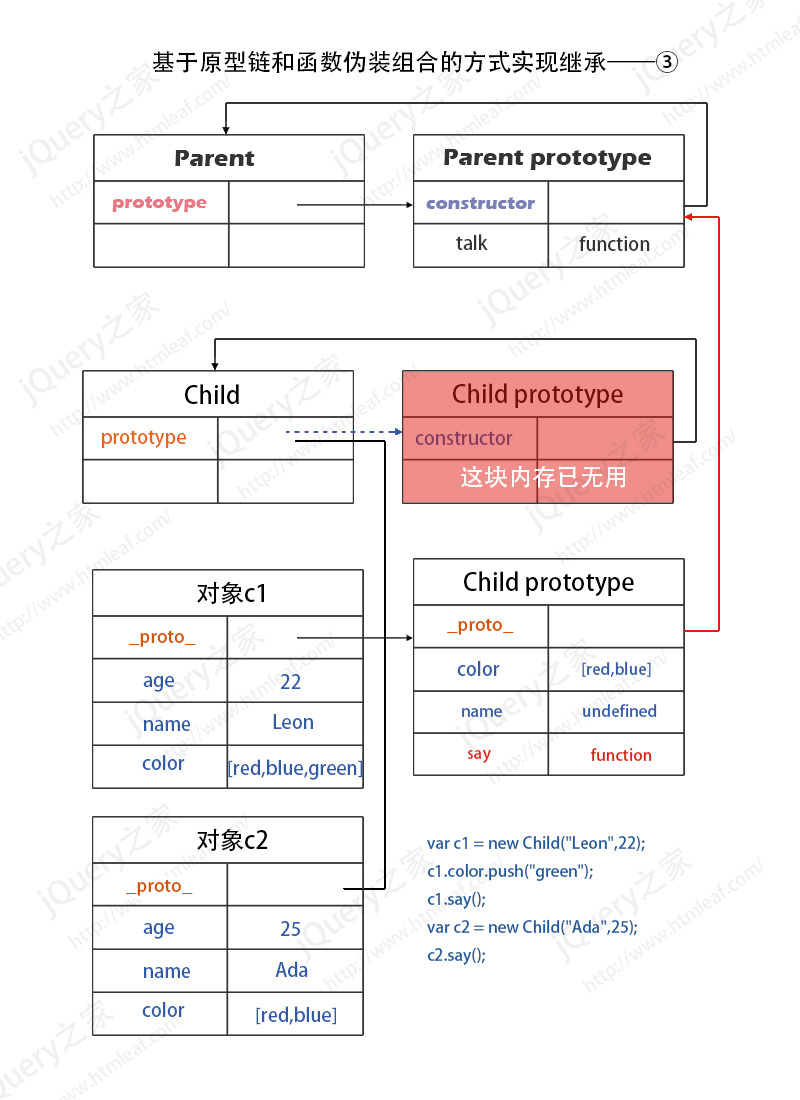 Web Front-end
Web Front-end
 JS Tutorial
JS Tutorial
 JavaScript object-oriented - inheritance based on prototype chain and function disguise combination
JavaScript object-oriented - inheritance based on prototype chain and function disguise combination
JavaScript object-oriented - inheritance based on prototype chain and function disguise combination
As mentioned above, we will not use the method based on function falsification alone to implement inheritance, but will use the method based on the prototype chain and function camouflage combination to implement inheritance. This inheritance method is also called pseudo-classical inheritance. Its idea is to use the prototype chain to inherit prototype properties and methods, and to inherit instance properties by borrowing constructors. In this way, function reuse is achieved by defining methods on the prototype, and each instance is guaranteed to have its own attributes.
Looking at the following example, we first list the complete inheritance code based on prototype chain and function camouflage combination, and then perform memory model analysis on each step in the code.
// 第一部分
function Parent(name){
this.color = ["red","blue"];
this.name = name;
}
Parent.prototype.talk = function(){
alert(this.name+"["+this.color+"]");
}
// 第二部分
function Child(name,age){
//函数伪造继承
Parent.call(this,name);
this.age = age;
}
// 原型链继承
Child.prototype = new Parent();
Child.prototype.say = function(){
alert(this.name+","+this.color);
}
//第三部分
var c1 = new Child("Leon",22);
c1.color.push("green");
c1.say(); // 输出:Leon[red,blue,green]
var c2 = new Child("Ada",25);
c2.say(); // 输出:Ada[red,blue]Let’s first look at the first part of the code. In this code, we create the parent class Parent and add 2 attributes to it. Then add a method talk() in the Parent prototype. The memory model at this time is shown in the figure below:

Next in the second part of the code, we created the subclass Child and used the function forged inside the subclass Child The method inherits the properties of the parent class. Then through prototype chain inheritance, the prototype of the subclass points to the parent class object, and a say() method is added to the new subclass prototype. The memory model at this time is as shown below:

Finally, in the third part of the code, we created two subclass objects c1 and c2 respectively. Then add a new color to the color attribute of the c1 object, and call the say() method of c1. Also call its say() method for c2. The memory model at this time is as shown below:

We can see that setting the value for the reference type attribute of the object is completed in its own space, so that each An object has its own independent properties that do not interfere with each other.
The above is the complete code and memory model analysis of inheritance based on prototype chain and function camouflage combination. It is also the most commonly used way to implement inheritance in JavaScript. For more related content, please pay attention to PHP Chinese Net (www.php.cn)!

Hot AI Tools

Undresser.AI Undress
AI-powered app for creating realistic nude photos

AI Clothes Remover
Online AI tool for removing clothes from photos.

Undress AI Tool
Undress images for free

Clothoff.io
AI clothes remover

Video Face Swap
Swap faces in any video effortlessly with our completely free AI face swap tool!

Hot Article

Hot Tools

Notepad++7.3.1
Easy-to-use and free code editor

SublimeText3 Chinese version
Chinese version, very easy to use

Zend Studio 13.0.1
Powerful PHP integrated development environment

Dreamweaver CS6
Visual web development tools

SublimeText3 Mac version
God-level code editing software (SublimeText3)

Hot Topics
 1386
1386
 52
52
 How to implement an online speech recognition system using WebSocket and JavaScript
Dec 17, 2023 pm 02:54 PM
How to implement an online speech recognition system using WebSocket and JavaScript
Dec 17, 2023 pm 02:54 PM
How to use WebSocket and JavaScript to implement an online speech recognition system Introduction: With the continuous development of technology, speech recognition technology has become an important part of the field of artificial intelligence. The online speech recognition system based on WebSocket and JavaScript has the characteristics of low latency, real-time and cross-platform, and has become a widely used solution. This article will introduce how to use WebSocket and JavaScript to implement an online speech recognition system.
 WebSocket and JavaScript: key technologies for implementing real-time monitoring systems
Dec 17, 2023 pm 05:30 PM
WebSocket and JavaScript: key technologies for implementing real-time monitoring systems
Dec 17, 2023 pm 05:30 PM
WebSocket and JavaScript: Key technologies for realizing real-time monitoring systems Introduction: With the rapid development of Internet technology, real-time monitoring systems have been widely used in various fields. One of the key technologies to achieve real-time monitoring is the combination of WebSocket and JavaScript. This article will introduce the application of WebSocket and JavaScript in real-time monitoring systems, give code examples, and explain their implementation principles in detail. 1. WebSocket technology
 How to use JavaScript and WebSocket to implement a real-time online ordering system
Dec 17, 2023 pm 12:09 PM
How to use JavaScript and WebSocket to implement a real-time online ordering system
Dec 17, 2023 pm 12:09 PM
Introduction to how to use JavaScript and WebSocket to implement a real-time online ordering system: With the popularity of the Internet and the advancement of technology, more and more restaurants have begun to provide online ordering services. In order to implement a real-time online ordering system, we can use JavaScript and WebSocket technology. WebSocket is a full-duplex communication protocol based on the TCP protocol, which can realize real-time two-way communication between the client and the server. In the real-time online ordering system, when the user selects dishes and places an order
 How to implement an online reservation system using WebSocket and JavaScript
Dec 17, 2023 am 09:39 AM
How to implement an online reservation system using WebSocket and JavaScript
Dec 17, 2023 am 09:39 AM
How to use WebSocket and JavaScript to implement an online reservation system. In today's digital era, more and more businesses and services need to provide online reservation functions. It is crucial to implement an efficient and real-time online reservation system. This article will introduce how to use WebSocket and JavaScript to implement an online reservation system, and provide specific code examples. 1. What is WebSocket? WebSocket is a full-duplex method on a single TCP connection.
 JavaScript and WebSocket: Building an efficient real-time weather forecasting system
Dec 17, 2023 pm 05:13 PM
JavaScript and WebSocket: Building an efficient real-time weather forecasting system
Dec 17, 2023 pm 05:13 PM
JavaScript and WebSocket: Building an efficient real-time weather forecast system Introduction: Today, the accuracy of weather forecasts is of great significance to daily life and decision-making. As technology develops, we can provide more accurate and reliable weather forecasts by obtaining weather data in real time. In this article, we will learn how to use JavaScript and WebSocket technology to build an efficient real-time weather forecast system. This article will demonstrate the implementation process through specific code examples. We
 Simple JavaScript Tutorial: How to Get HTTP Status Code
Jan 05, 2024 pm 06:08 PM
Simple JavaScript Tutorial: How to Get HTTP Status Code
Jan 05, 2024 pm 06:08 PM
JavaScript tutorial: How to get HTTP status code, specific code examples are required. Preface: In web development, data interaction with the server is often involved. When communicating with the server, we often need to obtain the returned HTTP status code to determine whether the operation is successful, and perform corresponding processing based on different status codes. This article will teach you how to use JavaScript to obtain HTTP status codes and provide some practical code examples. Using XMLHttpRequest
 How to use insertBefore in javascript
Nov 24, 2023 am 11:56 AM
How to use insertBefore in javascript
Nov 24, 2023 am 11:56 AM
Usage: In JavaScript, the insertBefore() method is used to insert a new node in the DOM tree. This method requires two parameters: the new node to be inserted and the reference node (that is, the node where the new node will be inserted).
 JavaScript and WebSocket: Building an efficient real-time image processing system
Dec 17, 2023 am 08:41 AM
JavaScript and WebSocket: Building an efficient real-time image processing system
Dec 17, 2023 am 08:41 AM
JavaScript is a programming language widely used in web development, while WebSocket is a network protocol used for real-time communication. Combining the powerful functions of the two, we can create an efficient real-time image processing system. This article will introduce how to implement this system using JavaScript and WebSocket, and provide specific code examples. First, we need to clarify the requirements and goals of the real-time image processing system. Suppose we have a camera device that can collect real-time image data



